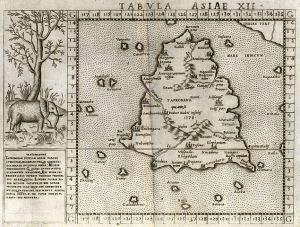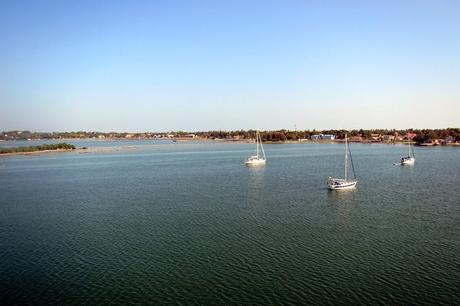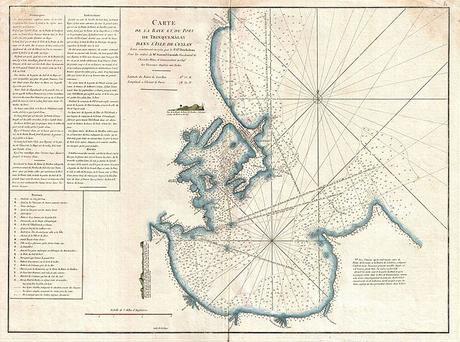
Trincomalee so far has been a feast of sights, sounds, smells, experiences. It has been both friendly and jarring, and I wake up wondering what each day will bring. But that’s getting ahead of things a little. First, we had to get here!
For years, cruising boats pointing to Sri Lanka all called in to Galle on the southwest side of Sri Lanka. Trincomalee – the fifth largest natural harbor in the world – was in LTTE (Tamil Tiger) territory on the northeast coast, and not considered a safe destination during the civil war that dragged on from 1986 to 2009. It’s a pity, because this natural deepwater port has been visited by seafarers from Lord Nelson to Marco Polo to Ptolemy. The only two other international ports were industrial, and not appealing as destinations.

Ruscelli-map-1562 Tamil vanni country” by Ruscelli 1562 – http://libweb5.princeton.edu/visual_materials/maps/websites/thematic-maps/introduction/ruscelli-map-1562.jpg. Licensed under Public Domain via Wikimedia Commons
Although the civil war ended nearly six years ago, cruiser habits seem to die hard, and only a couple of boats (literally, two) called on Trinco last year. Still, it’s a little surprising that the flow to Galle remained steady considering cruisers had descriptions like this one of the facilities:
“No matter how nice the people were ashore, especially on our travels around the island, the fact is that 70% of our time in Sri Lanka was spent sitting in a dirty, noisy, sewer; surging up and down with the swell, getting rocked around by passing launch and boat traffic and continually worried about sustaining damage. That, unfortunately, is the memory we will take away with us more than anything else.”
Way to sell Galle, right? But this is a typical reaction. And that doesn’t even mention you get to walk about a half mile just to get from the harbor gate to your boat (lots of fun for provisioning), or how risky it is to leave your boat unattended in the inadequate mooring setup (boats get damaged).

The fleet in Trinco from the masthead of SV Rutea, courtesy of Neal Schneider.
So last year, when friends of ours told us about a boat in Galle that had also gone to Trinco, I was interested. VERY interested! Larry was motivated to go to Trincomalee because his boat had been built nearby, and he hoped to find the yard. By pure chance I met him last June at the Rainforest World Music Festival in Borneo, and hearing how favorably he compared Trinco to Galle, from that point on it was decided in my head: we were going to Trincomalee. I just had to get an agent (required for clearance in Sri Lanka) that could help us, since the one Larry worked with was a gross disappointment at best.

“1775 Mannevillette Map of Trincomalee, Ceylon or Sri Lanka – Geographicus – TrinquemalayCeylon-mannevillette-1775” by http://www.geographicus.com/mm5/cartographers/mannevillette.txt – Mannevillette, D’Apres de, Le Neptune Oriental, 1775.This file was provided to Wikimedia Commons by Geographicus Rare Antique Maps, Licensed under Public Domain via Wikimedia Commons.
Emailing major shipping agents brought a few names forward, and GAC stood out as a better communicator; after some weeks of emailing we established a working agreement. It was slow only because they are accustomed to dealing with large merchant vessels here – tankers or cargo ships – and little sailing boats like ours are a completely different beast, and took some adjustments. For starters, we needed a different fee scale: our initial quote was for $2,000! We needed to be exempt from providing many of the information “required” by the port that simply isn’t followed by small private boats (like IMO security certificates and declared security levels). It provided interesting questions in advance of our arrival, such as the request for our draft at the forward and aft ends of Totem. I sent a line drawing and gave them our keel depth.
As the problems became more apparently surmountable, I wanted to get other boats in on the Trinco action! So I shared all the details with a loosely organized list of boats planning to cross the Indian Ocean. Momentum built around Trincomalee, and as a result, a dozen boats so far have called in at Trinco instead of Galle this year- and at least another half dozen are on the way.
NEXT: reality on the ground for checking into Trinco.
Savvy sailors know we love it when you read this on the Sailfeed website.

